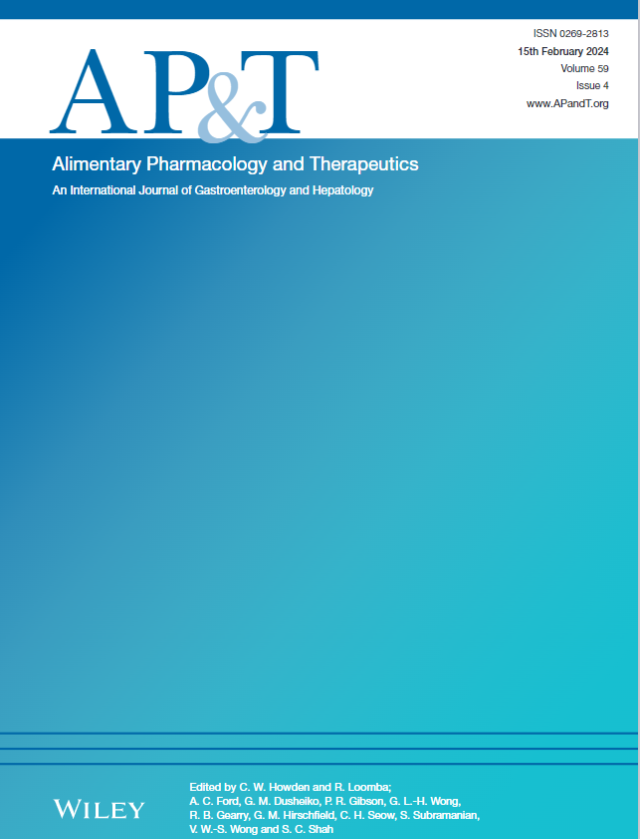Network Meta‐Analysis: Comparative Efficacy of Biologics and Small Molecules in the Induction and Maintenance of Remission in Crohn's Disease
IF 6.7
1区 医学
Q1 GASTROENTEROLOGY & HEPATOLOGY
引用次数: 0
Abstract
BackgroundAdvances in medical management of Crohn's disease (CD) have transformed therapeutic goals. Clinical and endoscopic remission are important endpoints.AimTo compare the efficacy of different advanced therapies in patients with CD.MethodsWe performed a literature search up to January 2025. We included phase 3 randomised controlled trials (RCTs) against placebo or an active comparator. The primary endpoint was induction and maintenance of clinical remission (CD Activity Index [CDAI] < 150 points). Secondary endpoints included induction and maintenance of endoscopic remission (Simple Endoscopic Score for CD (SES‐CD) of ≤ 4 or CD Endoscopic Index of Severity (CDEIS) of ≤ 4). We performed network meta‐analysis (NMA) using the Frequentist method.ResultsWe included 39 studies. Induction of clinical remission analysis showed that infliximab combination with azathioprine ranked highest (93.2%), followed by guselkumab (88.6%) and adalimumab (76.9%). Guselkumab was superior to most interventions in inducing clinical remission. In maintenance of clinical remission, combination of infliximab and azathioprine ranked highest (75.7%) followed by mirikizumab (71.8%) and guselkumab (71.5%). There was no statistically significant difference between therapies in maintaining clinical remission. In induction of endoscopic remission, upadacitinib (88.5%) ranked highest, followed by risankizumab (73.7%) and guselkumab (73.4%). Guselkumab (74%) ranked highest in maintaining endoscopic remission, followed by adalimumab (67%) and mirikizumab (64%).ConclusionNovel IL‐23 inhibitors (such as mirikizumab, risankizumab and guselkumab) and anti‐TNFs (such as infliximab and adalimumab) ranked high in the induction of clinical and endoscopic remission. This highlights the potential of novel advanced therapies for CD.网络荟萃分析:生物制剂和小分子药物在诱导和维持克罗恩病缓解中的比较疗效
背景:克罗恩病(CD)医学管理的进步已经改变了治疗目标。临床和内镜缓解是重要的终点。目的比较不同先进疗法对cd患者的疗效。方法检索截至2025年1月的文献。我们纳入了针对安慰剂或活性比较物的3期随机对照试验(rct)。主要终点是诱导和维持临床缓解(CD活性指数[CDAI] <;150分)。次要终点包括内镜缓解的诱导和维持(CD简单内镜评分(SES - CD)≤4或CD内镜严重程度指数(CDEIS)≤4)。我们使用Frequentist方法进行网络meta分析(NMA)。结果纳入39项研究。诱导临床缓解分析显示,英夫利昔单抗联合硫唑嘌呤排名最高(93.2%),其次是古塞库单抗(88.6%)和阿达木单抗(76.9%)。Guselkumab在诱导临床缓解方面优于大多数干预措施。在维持临床缓解方面,英夫利昔单抗联合硫唑嘌呤排名最高(75.7%),其次是米里珠单抗(71.8%)和古塞库单抗(71.5%)。两种治疗方法在维持临床缓解方面没有统计学上的显著差异。在诱导内镜缓解方面,upadacitinib(88.5%)排名最高,其次是risankizumab(73.7%)和guselkumab(73.4%)。Guselkumab(74%)在维持内窥镜缓解方面排名最高,其次是阿达木单抗(67%)和米rikizumab(64%)。结论新型IL - 23抑制剂(如mirikizumab、risankizumab和guselkumab)和抗tnf(如英夫利昔单抗和阿达木单抗)在诱导临床和内镜下缓解方面排名较高。这凸显了新型先进的乳糜泻治疗方法的潜力。
本文章由计算机程序翻译,如有差异,请以英文原文为准。
求助全文
约1分钟内获得全文
求助全文
来源期刊
CiteScore
15.60
自引率
7.90%
发文量
527
审稿时长
3-6 weeks
期刊介绍:
Alimentary Pharmacology & Therapeutics is a global pharmacology journal focused on the impact of drugs on the human gastrointestinal and hepato-biliary systems. It covers a diverse range of topics, often with immediate clinical relevance to its readership.

 求助内容:
求助内容: 应助结果提醒方式:
应助结果提醒方式:


